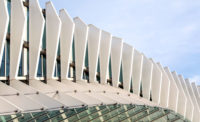An increasing number of California architects and contractors are employing building information modeling tools to enhance their use of green technology in new projects and renovations.
A 2010 Green BIM SmartMarket report from McGraw-Hill Construction, the publisher of California Construction, showed that 78% of companies that use software to share digital models of buildings’ functions plan to incorporate BIM within the next three years to measure sustainability.
The same report indicated 17% of green BIM practitioners believe they realize more than 50% of BIM’s potential to achieve green objectives.
“The growth of green projects will drive the growth of BIM use in the industry and, ultimately, productivity improvements in the design and construction industry,” according to the report.
Dramatic Results
Raymond Kahl, principal in charge at Atlanta-based Urban Design Group, says BIM allows a project team to take a holistic approach to design and construction.
“Modeling leads to lean construction, which is green construction,” Kahl says. His company designed the new University of Southern California School of Cinematic Arts, a $165-million, 137,000-sq-ft historic California-style complex built to LEED silver standards. The goal was to design a building that would last for the next 100 years.
Using Autodesk BIM solutions, including virtual design and construction methodologies, Kahl says he was able to analyze alternative daylighting and whole-building energy options to take full advantage of sunlight and wind onsite.
He estimates that the enhanced energy studies allow for buildings to be designed to perform up to 20% more efficiently.
BIM also reduced the amount of waste because it allowed estimates to be more precise with no revisionist work, no tearing out pieces for reinstalling and no overstock, Kahl says.
“Without modeling, we wouldn’t have been able to install as efficiently,” he adds. He also credits BIM for allowing greater use of prefabrication, which resulted in less waste and time spent in construction onsite.
Because models are shared in real time, the team could make decisions faster, contributing to a project that was delivered three months ahead of schedule and under budget, Kahl says.
Future Growth
The SmartMarket report showed that nongreen BIM companies ranked request by a client (36%) as the most-anticipated trigger of their future decision to use BIM for green projects. Other factors included market differentiation and improved capability to do green work.
Perhaps the biggest area for improvement is enhanced integration.
“The ability to leverage the capabilities of BIM to optimize sustainable design is still in its infancy,” says Erik Ring, an associate at LPA Inc. in Los Angeles. “In general, the data transfer between BIM platforms and other building analysis software (energy, lighting, computational fluid dynamics, etc.) is not as clean or comprehensive as the software vendors may promise.”
Ring says that LPA is hopeful that as both BIM and green building awareness continue to evolve, future software will provide more capability to develop BIM models, construction documents, building analysis and LEED documentation from common platforms.







Post a comment to this article
Report Abusive Comment